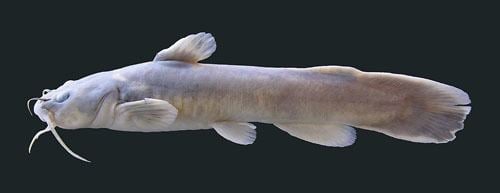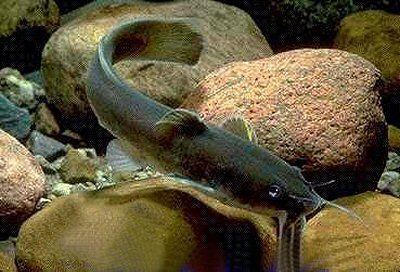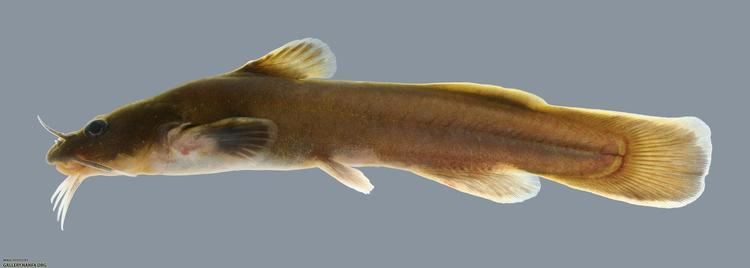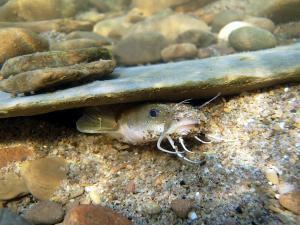Rank Species | Phylum Chordata Order Siluriformes Genus Noturus | |
 | ||
Similar Madtom, Tadpole madtom, Brindled madtom, Sand shiner, Shorthead redhorse | ||
Noturus flavus aquarium fish
Noturus flavus , the stonecat, is a North American freshwater catfish of the family Ictaluridae. Its common name is due to its habit of hiding near or under stones in fast-moving water.
Contents
- Noturus flavus aquarium fish
- Description
- Sizeage
- Distribution
- Habitat
- Diet
- Reproduction
- Etymology
- Importanceconservation status
- References

Description

Stonecats are small, slender, flat-headed catfishes, with the adipose fin keellike and continuous with the caudal fin except for a shallow notch. The upper jaw projects beyond the lower jaw and the tooth pad on the upper jaw has a narrow, crescent-shaped extension on each side. There are lateral backward extensions on the premaxillary band of teeth. Whereas the dorsal and pectoral spines of most members of this family cause wounds that irritate, the stonecat has poison glands, particularly on the bases of the pectoral spines, that cause extreme pain similar to that of a wasp sting with just one prick. The pectoral fin lacks any posterior serrae. Anal fin rays number 15 to 18, pectoral fin rays 9 to 11, and pelvic fin rays 8 to 10. The caudal fin rays number 55 to 67. The skin of the stonecat is thick and is yellowish-brown in color, the sides of the head shade to yellow, and the belly is whitish. The stonecat has two forms. In the Cumberland drainage in Tennessee, a scientifically undescribed form possesses two light bars (perpendicular to body length) on its nape. In other areas, a patch exists in place of the bars. In both forms, the stonecat has a white spot at the rear of the dorsal fin base and one on the upper edge of the caudal fin. There are either no or a few weak teeth on the rear of the pectoral spine.
Size/age

Stonecats typically reach four to eight inches in length, but can reach 12 inches, at weights of 0.22 to 1.1 lbs. They also typically live for five to six years.
Distribution

The stonecat has a widespread distribution. It exists in the Great Lakes, the St. Lawrence River, drainages of Hudson Bay, and the Mississippi River basin. It can be found from the Hudson River drainage of New York west to the Red River drainage of Hudson Bay. It is found in drainages of the Mississippi River basin from Quebec to Alberta, southerly to northern Alabama and Mississippi, and westerly to northeastern Oklahoma. In Colorado they are present in St. Vrain Creek near Longmont, Colorado and in the Republican River south of Wray, Colorado.
Habitat

Stonecats live in freshwater environments. They are found in large creeks and small rivers. They occasionally occur in tiny creeks, or rivers as large as the lower Mississippi. They occupy gently to fast-moving riffle areas with rocky substrates. Stonecats spend the majority of their time in moderate-moving, shallow riffles. They can also be found in deeper water (2 to 3 meters deep). Stonecats also occur in natural lakes, such as Lake Erie. There, they prefer rock and gravel bars that are subject to significant wave action.
Diet

The stonecat is a benthic, opportunistic feeder, using its sensitive barbels during the night to search for food on the river bottom. They eat a diversity of food items, such as aquatic insect larvae (such as mayflies), mollusks, minnows, fish eggs, isopods, amphipods, crayfish, plant material, worms, and chilopods.
Reproduction

Females mature at three to four years of age and a mean standard length of 4.7 inches. Stonecats form monogamous pairs for breeding, and spawn when water temperatures reach 25°C. Clutches are guarded by males under large, flat rocks in pools or crests of riffles. Rocks used as spawning cover averaged 200 square inches and were found in water averaging 34 inches deep. The eggs are amber-yellow and are very large, ranging between 3.5 and 4 mm in diameter, with the whole egg mass enveloped by a gelatinous material. A female stonecat may produce between 200 and 1,200 eggs per year. They exhibit parental care, with the male or both sexes guarding the clutch. They continue to guard them until they head to shallower, calmer streams and waters to mature.
Etymology

The genus name Noturus, meaning "back tail", refers to the fusion of the adipose and caudal fins. The specific epithet flavus meaning "yellow", refers to the color distinction.
Importance/conservation status
Stonecats serve as indicators of water quality. They are not present in highly polluted or heavily silted areas. Stonecats are a very valuable indicator species to humans. They may also be useful as a marker for water temperature.
The US Endangered Species Act lists the status of Noturus flavus as not threatened or no special status, meaning there is no threat of this species going extinct.
